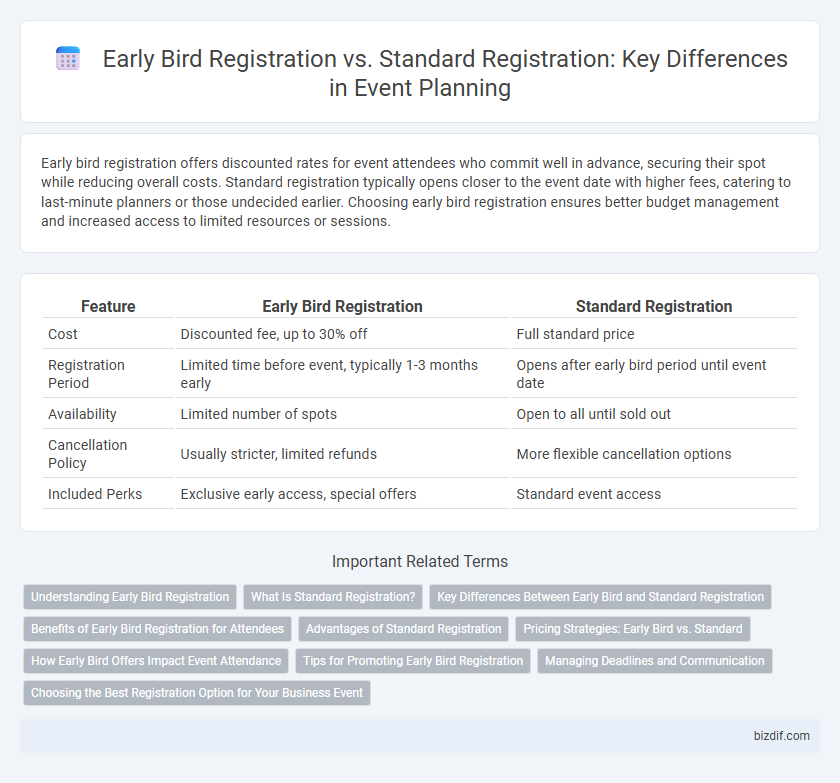Early bird registration offers discounted rates for event attendees who commit well in advance, securing their spot while reducing overall costs. Standard registration typically opens closer to the event date with higher fees, catering to last-minute planners or those undecided earlier. Choosing early bird registration ensures better budget management and increased access to limited resources or sessions.
Table of Comparison
| Feature | Early Bird Registration | Standard Registration |
|---|---|---|
| Cost | Discounted fee, up to 30% off | Full standard price |
| Registration Period | Limited time before event, typically 1-3 months early | Opens after early bird period until event date |
| Availability | Limited number of spots | Open to all until sold out |
| Cancellation Policy | Usually stricter, limited refunds | More flexible cancellation options |
| Included Perks | Exclusive early access, special offers | Standard event access |
Understanding Early Bird Registration
Early bird registration offers attendees discounted rates for signing up well before the event date, providing event planners with early revenue and a clearer headcount for logistics. This registration phase incentivizes prompt commitment, helping optimize marketing efforts and resource allocation. Understanding early bird registration allows organizers to balance pricing strategy and maximize participation by leveraging urgency and value perception.
What Is Standard Registration?
Standard registration is the regular enrollment period for event attendees, typically opening after the early bird deadline has passed. It offers full access to event sessions, workshops, and networking opportunities without the discounted rates available during early bird registration. Most organizers use standard registration as the primary ticket sales phase, reflecting the event's regular pricing structure and policies.
Key Differences Between Early Bird and Standard Registration
Early bird registration offers discounted rates and secures attendance well in advance, while standard registration typically incurs higher fees and starts closer to the event date. Early bird registrants benefit from guaranteed spots and often receive exclusive perks, whereas standard registration is more flexible but may risk event capacity limits. Choosing early bird registration optimizes budget savings and ensures participation in high-demand events.
Benefits of Early Bird Registration for Attendees
Early bird registration offers attendees significant cost savings, often providing discounts of up to 30% compared to standard registration fees. Securing a spot early ensures access to limited-capacity sessions and premium seating options, enhancing the overall event experience. Attendees also benefit from extended planning time, allowing for better travel arrangements and accommodation bookings, which contribute to a stress-free event participation.
Advantages of Standard Registration
Standard registration offers the advantage of flexibility, allowing attendees to finalize their plans closer to the event date without missing out on participation. This option often includes access to full event features, workshops, and networking sessions that may be limited or unavailable during early bird registration. Standard registrants benefit from updated event details and last-minute adjustments, ensuring they receive the most current experience and resources.
Pricing Strategies: Early Bird vs. Standard
Early bird registration offers a discounted price to incentivize early sign-ups, increasing cash flow and attendee commitment well before the event date. Standard registration prices are set higher to capture last-minute registrants, balancing demand after the early bird period ends. This tiered pricing strategy maximizes overall revenue while optimizing attendance forecasting and resource allocation.
How Early Bird Offers Impact Event Attendance
Early bird registration significantly boosts event attendance by incentivizing early commitment through discounted pricing, creating a sense of urgency among potential attendees. Data shows events with early bird offers experience up to a 30% increase in early sign-ups, which enhances budget forecasting and resource allocation for organizers. This early influx of participants also helps generate momentum and social proof, attracting more registrations during the standard period.
Tips for Promoting Early Bird Registration
Promoting early bird registration effectively involves creating a sense of urgency with limited-time offers and exclusive discounts tailored to target audiences interested in event planning. Utilize email marketing campaigns, social media platforms, and event websites to highlight the tangible benefits of early registration, such as cost savings and priority access to sessions or networking opportunities. Leveraging testimonials and success stories from past attendees can also increase credibility and encourage prompt sign-ups during the early bird phase.
Managing Deadlines and Communication
Early bird registration offers incentives for participants to commit early, allowing event planners to secure attendance numbers and allocate resources efficiently. Managing deadlines for early bird versus standard registration requires clear communication through multiple channels, such as email reminders and social media updates, to maximize enrollment before cutoff dates. Effective deadline management reduces last-minute rushes and enhances overall event organization by providing accurate attendance forecasts.
Choosing the Best Registration Option for Your Business Event
Early bird registration offers discounted rates and secures attendance spots early, providing budget predictability and improved event planning for your business. Standard registration, while typically more expensive, offers flexibility for late decision-makers and accommodates last-minute attendees. Analyzing your event's timeline, target audience, and cash flow priorities helps determine the optimal registration option for maximizing participation and revenue.
Early bird registration vs Standard registration Infographic

 bizdif.com
bizdif.com